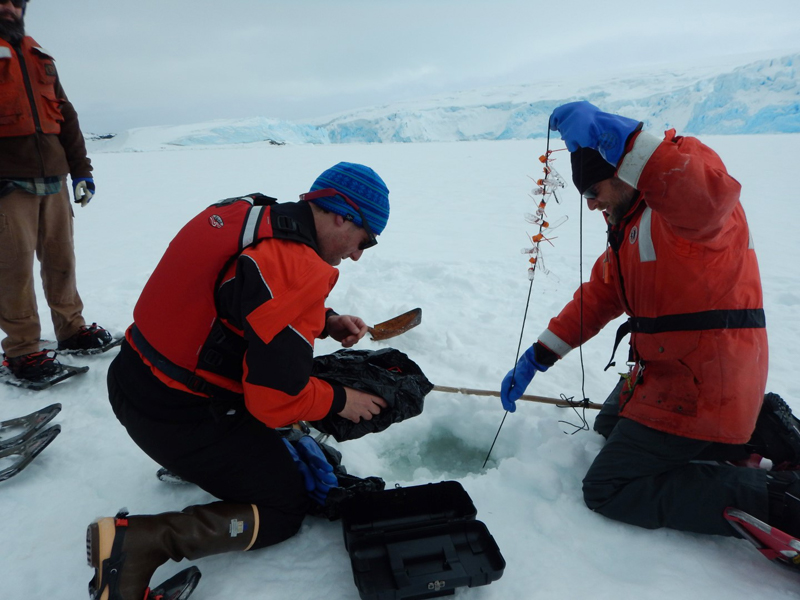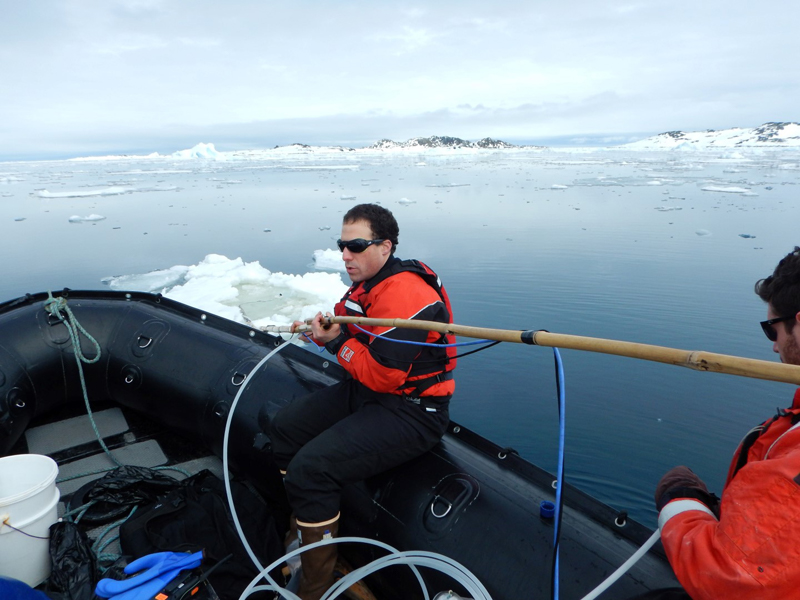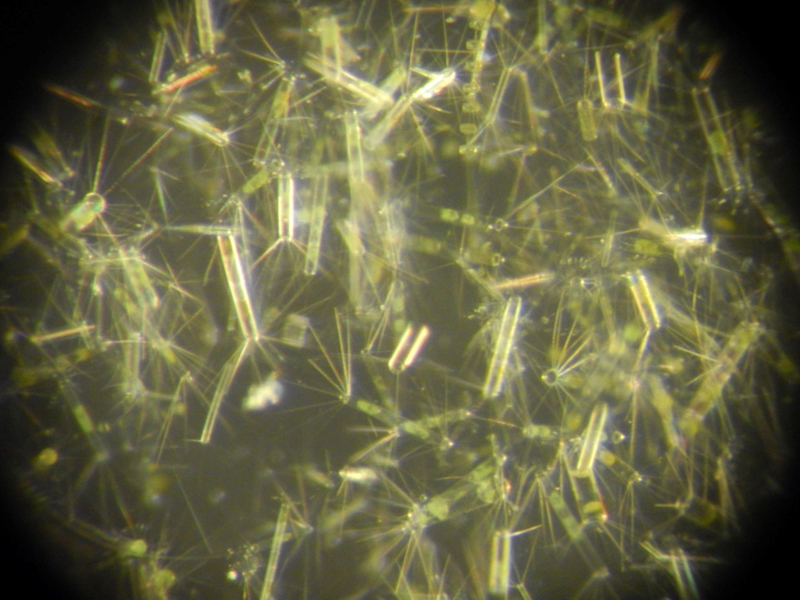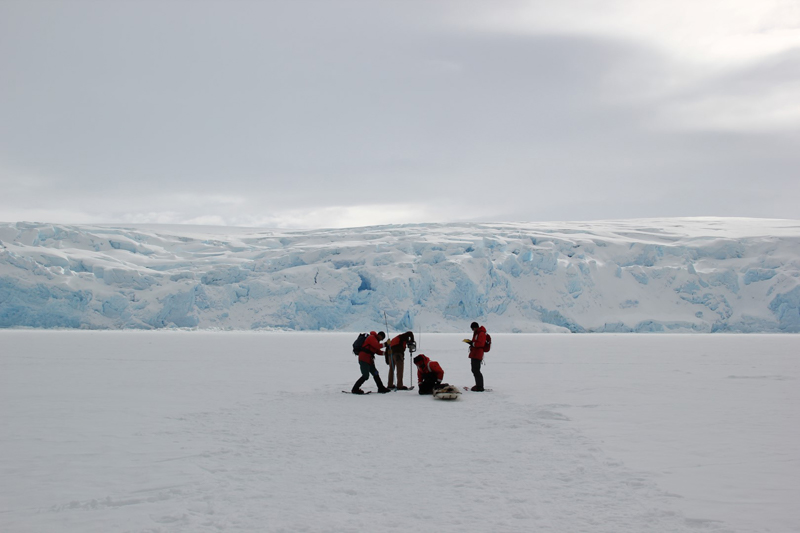
Photo Credit: Benjamin Van Mooy
|
Benjamin Van Mooy (right) and Jamie Collins take water samples from under the ice in Arthur harbor. |
Ultraviolet Radiation Gives Microbes Mixed Messages
The ozone hole may be causing more problems than just sunburn
By Michael Lucibella, Antarctic Sun Editor
Posted May 15, 2018
Ultraviolet rays from the sun may be disrupting the natural ecology of the waters of Antarctica’s Southern Ocean. A research team, led by a scientist from the Woods Hole Oceanographic Institution, is taking a close look at the effects that excess UV radiation at the cellular level to see what it means for marine ecosystems and the regional food web.

Photo Credit: Benjamin Van Mooy
Jamie Collins uses a pole to extend his sampling tube out over the side of one of Palmer Station's small Zodiac boats.
Ultraviolet radiation is a high-energy wavelength of light that can damage a cell’s DNA and causes sunburn in humans.
But the team led by Benjamin Van Mooy, a senior scientist at Woods Hole, is taking a different look at how it can affect microorganisms. They’re focusing on its effect on long molecule chains called lipids, that make up the cell walls of living creatures and how UV may disrupt communications within living cells.
As an analogy, at the cellular level, “it’s as if you’re at a rock concert before the show starts, talking with a friend at room volume and carrying on some sort of intelligent conversation,” said Jamie Collins, a post-doctoral student at the University of Washington and project co-investigator. “Once the music starts, it becomes very hard to convey that specific information you were trying to convey in your room level conversation because you’re flooded from all this other noise from all around you.”
The research is supported by the National Science Foundation (NSF), which manages the U.S. Antarctic Program.
Van Mooy’s group recently spent their first field season at NSF’s Palmer Station on the Antarctic Peninsula, collecting water samples.
“We did a lot of sampling down there all across the food web from bacteria all the way up to krill,” said Van Mooy, a senior scientist at the Woods Hole Oceanographic Institution and principal investigator on the project. “We did a lot of experiments as well, spent some time on the ice, it was amazing.”
Scrambled Communications

Photo Credit: Benjamin Van Mooy
There's a whole menagerie of microorganisms living off of Palmer Station that can only be seen with a microscope.
Instead of actually damaging or changing the DNA of the microorganisms, the radiation can produce chemicals in the water that can effectively scramble a microorganisms’ ability to communicate.
“We know a lot of things about how the ultraviolet radiation can actually affect the DNA in these organisms. It’s mutagenic, so it can cause DNA to change,” said Jamie Collins, a post-doctoral student at the University of Washington and project co-investigator. “Very little has gone into the effect of UV radiation on lipids.”
Cells communicate both internally and with one another using long strings of molecules called “infochemicals.”
“Most times these signals get created enzymatically, so an organism has a gene that allows it to make a protein or an enzyme that then makes its own molecules and turns them into signals, but that happens in a very specific way,” Collins said.
These infochemicals are long molecular strings that effectively act as the programming language of a cell. There are many ways that different microorganisms use these info-chemicals, both to run their own cellular engines and to communicate to other nearby organisms.
“These signals can be used to help organisms regulate their use of certain nutrients,” Collins said. “If you [as a cell] can get a tip from your genetic kin that a certain nutrient is in short supply you might be able to temporarily reconfigure your own cellular apparatus to use less of it in the short term.”

Photo Credit: Jamie Collins
Using drills and ice probes, the research team punches through the sea ice in Arthur harbor, with the help of a few of the station's support staff.
The Van Mooy group is investigating whether an alternate source of these signaling chemicals might be entering the ecosystem and scrambling the otherwise organized cellular communication.
“These molecules are produced enzymatically, on purpose, for these organisms to communicate, but could they also be produced abiotically, by a non-biological sort of uncontrolled environmental process, ultraviolet radiation?” Collins said.
They think an “artificial” source could be from the excess ultraviolet radiation bombarding the ocean surface. It’s radiation that would have been otherwise blocked, but is passing through the pollutant-induced ozone hole.
“You have this enormous dose of UV radiation that’s received at the surface of the ocean,” Collins said. “These intense wavelengths of light can penetrate surprisingly deeply into the surface of the ocean.”
As far down, he said, as the first 5 to 10 feet of the ocean, affecting the creatures living near the surface.
“We’re really interested in lipids, ” Collins said. “They give the cell structure. So the cell wall of all the cells in the human body and all these single-celled organisms that live in the ocean are made up of lipids and they store energy and they can act as signal between organisms and members of the same species as well.”
UV radiation penetrating into the ocean can actually break apart water molecules, forming types of oxygen molecules called reactive oxygen species. These molecules quickly bond with any nearby lipids, oxidizing them.
“When these lipid molecules are oxidized, they take on totally different functions,” Van Mooy said. “Instead of just being a passive molecule in the membrane they can become a signal for communication between microbes, or an intracellular physiological signal for the organism itself.”
The researchers theorize that this deluge of ultraviolet-induced infochemicals flooding the oceans could overwhelm the natural communication between species.
Previous
1
2
Next








